 |
| |
 |
 |
 |





 View of Our Hotel
View of Our Hotel
View of Our Hotel
View of Our Hotel |
 |
|
 |
 |
 |
| |
 |
UDAIPUR is situated in the biggest State of India: Rajasthan - the " Land of the Kings"- at the bottom of the mountain range Aravali in a valley 577m above the sea level. Udaipur - the "City of the Lakes" or the "Venice of the East" - is a "smaller" Indian city with a population around 500.000, founded in 1559 by Maharana Udai Singh II. |
| |
City Palace |
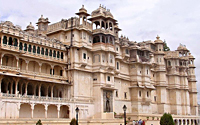 City Palace is the largest palace in Rajasthan, located on the eastern shore of Lake Pichola, it is a massive fortified structure, presenting an amazing blend of Rajasthani and Mughul architecture covering an area of 5 acres. The Facade of the Palace resembles a fortress. The halls and courtyards of the Palace’s older section are linked by narrow passages and steep stair cases. The Tripolia gate and the Ganesh Deorhi gate are the major gates of the City Palace. City Palace is the largest palace in Rajasthan, located on the eastern shore of Lake Pichola, it is a massive fortified structure, presenting an amazing blend of Rajasthani and Mughul architecture covering an area of 5 acres. The Facade of the Palace resembles a fortress. The halls and courtyards of the Palace’s older section are linked by narrow passages and steep stair cases. The Tripolia gate and the Ganesh Deorhi gate are the major gates of the City Palace.
|
| |
Lake Palace |
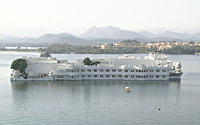 Lake Palace is one of the most romantic Places on this earth, situated amidst the scenic Pichola Lake offers a heavenly view to the on looker. The imposing Aravalli Hills on one side and soaring palaces on the other, make the perfect background to this beautiful Lake Palace. Raised in white marble, Lake Palace was constructed by Maharana Jai Singh II in 1746. The magnificent Palace stretches across a four-acre island creating a dream-like impression. Lake Palace is one of the most romantic Places on this earth, situated amidst the scenic Pichola Lake offers a heavenly view to the on looker. The imposing Aravalli Hills on one side and soaring palaces on the other, make the perfect background to this beautiful Lake Palace. Raised in white marble, Lake Palace was constructed by Maharana Jai Singh II in 1746. The magnificent Palace stretches across a four-acre island creating a dream-like impression.
|
| |
Jag Mandir Palace |
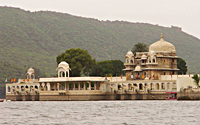 Jag Mandir Palace located on the southern island of Lake Pichola. The three-storied palace built in early years of 17th century is a palatial structure made in yellow sandstone and marble. Jag Mandir Palace located on the southern island of Lake Pichola. The three-storied palace built in early years of 17th century is a palatial structure made in yellow sandstone and marble.
|
| |
Jagdish Temple |
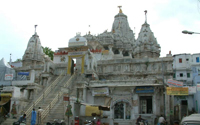 Jagdish Temple is one of the famous temples of Udaipur made in Indo-Aryan style of architecture in the year 1651, was built by Maharana Jagat Singh, who ruled Udaipur during 1628-53. The temple is dedicated to Lord Vishnu (Laxmi Narayan), the preserver of the Universe. It is celebrated for being the largest temple in the city of Udaipur. The gateway of this temple can be sited at a distance of 150 meters from the Bara Pol of the City Palace. Jagdish Temple is one of the famous temples of Udaipur made in Indo-Aryan style of architecture in the year 1651, was built by Maharana Jagat Singh, who ruled Udaipur during 1628-53. The temple is dedicated to Lord Vishnu (Laxmi Narayan), the preserver of the Universe. It is celebrated for being the largest temple in the city of Udaipur. The gateway of this temple can be sited at a distance of 150 meters from the Bara Pol of the City Palace.
|
| |
Gulab Bagh |
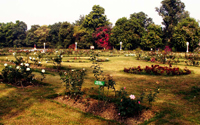 Also known as Sajjan Niwas Garden is the largest garden of Rajasthan, sprawled over 100 acres of land. During 1850's, Maharana Sajjan Singh took the initiative to built this beautiful garden. Sajjan Niwas Bagh is celebrated for its numerous varieties of roses, this garden is also known as Gulab Bagh or Rose Garden. Also known as Sajjan Niwas Garden is the largest garden of Rajasthan, sprawled over 100 acres of land. During 1850's, Maharana Sajjan Singh took the initiative to built this beautiful garden. Sajjan Niwas Bagh is celebrated for its numerous varieties of roses, this garden is also known as Gulab Bagh or Rose Garden.
|
| |
Bhartiya Lok Kala Mandal |
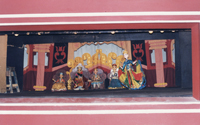 Bhartiya Lok Kala Museum is one of the most famous museums of Udaipur, exhibiting the brilliant collection of folk articles of Rajasthan from typical rural-dresses, ornaments, puppets, masks, dolls, folk musical instruments, folk deities and paintings. The museum is comfortably located in the building of Bhartiya Lok Kala Mandal near Chetak Circle in Udaipur city. Bhartiya Lok Kala Museum is one of the most famous museums of Udaipur, exhibiting the brilliant collection of folk articles of Rajasthan from typical rural-dresses, ornaments, puppets, masks, dolls, folk musical instruments, folk deities and paintings. The museum is comfortably located in the building of Bhartiya Lok Kala Mandal near Chetak Circle in Udaipur city.
|
| |
Sahelion Ki Bari |
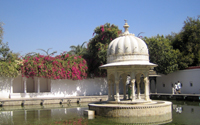 Sahelion Ki Bari "Garden of maids" is a major tourist destination in Udaipur. The garden is famous for its lush green lawns, marble art and fountains, presenting a green retreat in the dry lands of Rajasthan. Garden of maids was built in the 18th century by Maharana Sangram Singh for the royal ladies. Sahelion Ki Bari "Garden of maids" is a major tourist destination in Udaipur. The garden is famous for its lush green lawns, marble art and fountains, presenting a green retreat in the dry lands of Rajasthan. Garden of maids was built in the 18th century by Maharana Sangram Singh for the royal ladies.
|
| |
Sukhadia Circle |
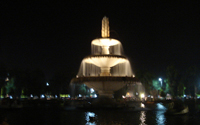 Sukhadia Circle, also known as Sukhadia square is a popular landmark in Udaipur and provides a beautiful view with the illumination of lights. This square, opened in 1970, has a magnificent three tiered fountain in the center and a structure representing the prosperity. This place is used as an evening relaxation place with beautiful gardens and a nice pond. Sukhadia Circle, also known as Sukhadia square is a popular landmark in Udaipur and provides a beautiful view with the illumination of lights. This square, opened in 1970, has a magnificent three tiered fountain in the center and a structure representing the prosperity. This place is used as an evening relaxation place with beautiful gardens and a nice pond.
|
| |
Fateh Sagar Lake |
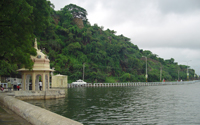 Fateh Sagar Lake is the second artificial lake of Udaipur, the first being Jaisamand Lake. Located in the north of Lake Pichola, Fateh Sagar Lake lies just besides the entrance to Moti Magri Hill. Built in 1678 by Maharana Jai Singh, Fateh Sagar Lake got its name from Maharana Fateh Singh, who later made additions to it. The lake extends to the length of 2.4 km, 1.6 km. in width and deep to the extent of 11.5 meter. During the monsoons, the lake covers the total area of around 1 sq km. Fateh Sagar Lake is the second artificial lake of Udaipur, the first being Jaisamand Lake. Located in the north of Lake Pichola, Fateh Sagar Lake lies just besides the entrance to Moti Magri Hill. Built in 1678 by Maharana Jai Singh, Fateh Sagar Lake got its name from Maharana Fateh Singh, who later made additions to it. The lake extends to the length of 2.4 km, 1.6 km. in width and deep to the extent of 11.5 meter. During the monsoons, the lake covers the total area of around 1 sq km.
|
| |
Maharana Pratap Memorial (Moti Magri) |
 Maharana Pratap Memorial is a historic site that is dedicated to Maharana Pratap. Situated at the top of Moti Margi or Pearl Hill, the memorial overlooks the Fateh Sagar Lake. Maharana Pratap Memorial was constructed with the initiative taken by Maharana Bhagwat Singh Mewar with the help of a public trust. Maharana Pratap Memorial is a historic site that is dedicated to Maharana Pratap. Situated at the top of Moti Margi or Pearl Hill, the memorial overlooks the Fateh Sagar Lake. Maharana Pratap Memorial was constructed with the initiative taken by Maharana Bhagwat Singh Mewar with the help of a public trust.
|
| |
Pichola Lake |
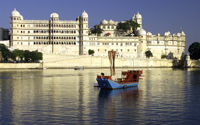 Pichola Lake is one of the most beautiful and picturesque lakes of Rajasthan, India. Located in the heart of the city, Pichola Lake is the oldest and one of the largest lakes of Udaipur. In 1362, the beautiful lake was built by Pichhu Banjara during the ruling period of Maharana Lakha is extended to 3 miles in length, 2 miles in width and has depth of 30 feet. Pichola Lake is one of the most beautiful and picturesque lakes of Rajasthan, India. Located in the heart of the city, Pichola Lake is the oldest and one of the largest lakes of Udaipur. In 1362, the beautiful lake was built by Pichhu Banjara during the ruling period of Maharana Lakha is extended to 3 miles in length, 2 miles in width and has depth of 30 feet.
|
| |
Bagore Ki Haveli |
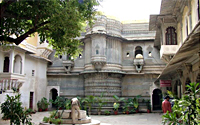 Bagore Ki Haveli is an ancient building that stands on the platform of Gangori Ghat in the vicinity of Pichola Lake. The splendid architecture of the mansion boasts of delicate carved and excellent glass work. In the eighteenth century, Bagore Ki Haveli was built by Amir Chand Badwa, who was the Chief Minister at the Mewar Royal Court in earlier times. Bagore Ki Haveli is an ancient building that stands on the platform of Gangori Ghat in the vicinity of Pichola Lake. The splendid architecture of the mansion boasts of delicate carved and excellent glass work. In the eighteenth century, Bagore Ki Haveli was built by Amir Chand Badwa, who was the Chief Minister at the Mewar Royal Court in earlier times.
|
| |
Ahar |
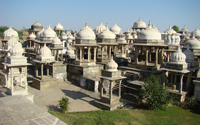 Ahar is a small town in the Udaipur district of Rajasthan. The place is famous for being the cremation ground of the rulers of Mewar. Today, Ahar is also renowned as an archeological site that offers interesting facts to archaeologists and research scholars. Ahar is famous for the cenotaphs of the Royal rulers and an archeological museum. Ahar is located at a comfortable distance of 3 kms from the city of Udaipur. You can take regular buses from the city or can reach Ahar by hiring private taxis. Ahar is a small town in the Udaipur district of Rajasthan. The place is famous for being the cremation ground of the rulers of Mewar. Today, Ahar is also renowned as an archeological site that offers interesting facts to archaeologists and research scholars. Ahar is famous for the cenotaphs of the Royal rulers and an archeological museum. Ahar is located at a comfortable distance of 3 kms from the city of Udaipur. You can take regular buses from the city or can reach Ahar by hiring private taxis.
|
| |
Shilpgram |
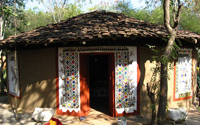 West Zone Cultural Centre has set up an artisan’s village called - Shilpgram, 3 Kms west of Udaipur. It is a living ethnographic museum depecting life style, traditions, customs and folk arts of the rural and tribal people of the states of Rajasthan, Maharashtra, Gujrat, Goa, Daman, etc. There are several huts constructed in the traditional architectural style using mud and local building material to reflect the geographical and ethnic diversity of the different states of west zone of India. West Zone Cultural Centre has set up an artisan’s village called - Shilpgram, 3 Kms west of Udaipur. It is a living ethnographic museum depecting life style, traditions, customs and folk arts of the rural and tribal people of the states of Rajasthan, Maharashtra, Gujrat, Goa, Daman, etc. There are several huts constructed in the traditional architectural style using mud and local building material to reflect the geographical and ethnic diversity of the different states of west zone of India.
|
| |
Sajjangarh (Monsoon Palace) |
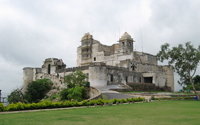 A former Monsoon Palace 1100 ft. high above the surrounding and 3100 ft. from sea level was built by Maharana Sajjan Singh in 1884. The palace looks its best during the rainy season. It offers a panoramic overview of the city’s lakes, palaces and surrounding. The hillside is thickly wooded and the former rulers maintained this as a royal shooting preserve. A former Monsoon Palace 1100 ft. high above the surrounding and 3100 ft. from sea level was built by Maharana Sajjan Singh in 1884. The palace looks its best during the rainy season. It offers a panoramic overview of the city’s lakes, palaces and surrounding. The hillside is thickly wooded and the former rulers maintained this as a royal shooting preserve.
|
|
|
|
|
|
|
 |
 |
 |
|
 |